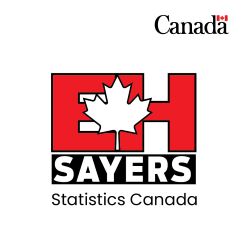Eh Sayers Episode 2 - Unravelling: Impacts of COVID-19 on Canadian families
Release date: December 7, 2021
Catalogue number: 45-20-0003
ISSN: 2816-2250

The pandemic presented a long list of threats to the mental and physical well-being of children, parents and educators across the nation. To help end the pandemic and return to normalcy, policy makers had to make difficult choices, such as closing schools. With our guest, Dr. Kelley Zwicker, a pediatrician at CHEO, we discussed the potential short- and long-term effects of the school closures on children and their parents.
Host
Tegan Bridge
Guest
Dr. Kelley Zwicker, Pediatrician
Listen to audio
Eh Sayers Episode 2 - Unravelling: Impacts of COVID-19 on Canadian families - Transcript
Zoe: Hi my name is Zoe. I am a kindergarten teacher in Ontario, Canada, and I've been lucky enough to teach kindergarten through a pandemic. There have been many challenges through this school year. A big one was having to try and separate kindergarten students and do physical distancing with them. The handwashing is easy, the distancing, not so much.
Joey: My name is Joey. My province is Ontario, and I'm in grade 3, next year going to be in to grade 4.
Tony: And what did you like most about this year?
Joey: I had amazing teachers, amazing friends, and I got to be at school for a little bit.
Zoe: We were able to create some groups within our classroom. They played with those students in the groups every day. They were allowed to mingle outside a little bit more. But it was quite a challenge trying to separate them in any way, shape, or form. Mask wearing was another difficulty for kids. They're four and five years old, so even if they did wear a mask, it often ended up in their mouths. It was so much easier and cleaner to not wear a mask for them.
Adapting... there was a lot of that this year. We had a to adapt to in-person learning with mask wearing and social distancing. We had to change what toys we put out for the kindergarteners. We had to change how we were teaching. And then we had to adapt again to teach virtually twice.
[Theme]
Tegan: Welcome to Eh Sayers, a podcast from Statistics Canada, where we meet the people behind the data and explore the stories behind the numbers. I'm your host Tegan.
I don't have kids, but I do know a lot of kids, and I know that this year has not been easy for them. It hasn't been easy for lots of us. We may all have felt pretty powerless, doing what small things we can to keep each other safe. But I think there's something unique in the ways kids experienced this past year.
One thing about being a kid is that you don't always have a lot of control, and you don't always get to make your own decisions. You don't drive the car. You sit in the back and ask, "Are we there yet?" But your parents know the rules of the road, and they know how to drive. They know where they're going. But this year, year and a half, none of us knew where we were going. None of us knew how long this trip was going to take. And when the kids inevitably ask, "Are we there yet? How long until we're done?" None of us had the answer. And that's weird for kids. Because the grown-ups always have the answer. Don't they?
So that's what we're going to explore today. What it's been like to sit in the backseat. What it was like to be a kid in the COVID-19 pandemic.
You'll hear a few voices today. You heard from Zoe and Joey at the top of the show, and you'll hear from others, kids and people who work with them or raise them.
First I'd like to introduce you to Dr. Kelley Zwicker, a pediatrician and founder of the Ottawa Community Pediatricians Network. Dr. Kelley, welcome to the show.
Tegan: So what's it been like being a doctor during a pandemic?
Kelley: It's been challenging and enlightening all at the same time. I think there's some really scary and things that were not obvious that emerged from the pandemic, and I think that it also has offered an opportunity for people just to be still and to think about what's really important and hopefully if we can find a way to navigate through both of those things we'll all come out OK. On the other side.
Tegan: Why did you found the Ottawa Community pediatricians network?
Kelley: I think the answer to that is related to the sense of floundering that we felt in the community and as healthcare providers in the beginning of the pandemic. So back in March
Tegan: That's March 2020.
Kelley: More than a year ago now, as individual practitioners that are not always associated with a larger institution or academic center, we felt a little bit alone and we felt like we were trying to figure out processes. So one of the things that we didn't have was PPE, so personal protective equipment, masks, gloves, gowns, and we also didn't know what we were supposed to be wearing and what we were supposed to be doing like in our offices, even if we did have that PPE. So, myself and the division head actually of community pediatrics. She's been the division head for about 25 years. Her name is Kathy Kiely, and she and I decided to bring people together from the division, and then we extended it to pediatricians outside of the division, all of the independent practitioners, so that we can all be on the same page and share information and support each other. And so it really came from a necessity to protect our patients and to protect ourselves. And it evolved into something really lovely and really supportive. And it's now a conduit to share information, but also to help advocate on common topics that we feel strongly about. For example, like school closures in Ontario and some other really key advocacy things. Right now we're working on vaccine hesitancy, and it also provided an opportunity to bring in experts in certain fields to, kind of, learn more and maintain that continuing medical education and to break down barriers to care.
Tegan: In many ways, the biggest threat to kids isn't necessarily the virus. It's often the measures we've had to take to stop the spread of the disease. So could you talk about that a little bit?
Kelley: So this is a really important question and I appreciate that you asked. I refer to the Canadian Paediatric Society, who published a recent statement in May 2021, that notes that children and youth less than 19 years make up 19% of all Canadian cases, so not a large proportion. And of that less than 2% of hospitalizations are children and youth under 19. Mortality rate in kids is less than 1%. It's .04%, and we see milder disease in children. And this could be related to the fact that the virus doesn't have as many receptors to bind to in children's bodies compared to adults. And so fortunately there has been very little medical morbidity of COVID-19 directly in children. If you look at what's happened since we've closed the schools, we see lack of socialization, lack of regular social programming, significant lack in family supports and a huge increase in mental health conditions, like eating disorders, anxiety, depression, self-harm, social malnutrition, physical inactivity, either a decline in body mass index in the form of a disorder or an increase in body mass index from obesity because there is a multitude of screen addiction and sleep dysfunction. And those are the things that pop into my head just from the last week of clinic that I've seen in relation to the effects of the pandemic on kids.
Tegan: Results from the new Canadian Health Survey on Children and Youth indicate that 4% of children and youth aged 1 to 17, as reported by their parents, had fair or poor mental health in 2019, one year prior to the pandemic. The survey also found that poor mental health among children and youth was associated with adverse health and social outcomes, such as lower grades and difficulty making friends.
Crowdsourced data suggest that the perceived mental health of Canadian youth has declined during the pandemic, with over half of participants aged 15 to 17 reporting that their mental health was somewhat worse or much worse than it was prior to the start of physical distancing.
Tegan: Is it hard to balance competing needs in this situation? So on the one hand you have to stop the spread, on the other you have to consider the well-being of kids whose development and education might be suffering in virtual learning situation.
Kelley: So in the beginning I would say yes, and I say that with the caveat that I'm not a public health expert and I have the utmost respect for those that make these decisions, and I think that our guidance and our approach comes from their leadership, and in the beginning when we didn't know how it was going to affect pediatric populations. I mean we have a bit of evidence from China looking at the lower rates in kids and from other European countries, but we didn't want to let our guard down and we also didn't want to assume that there weren't going to be new variants that would emerge that would affect the younger population. So in the beginning, yes, I feel like that balance was trickier, but in the beginning people weren't fatigued, and people had more energy and it was easier to do what was good for others. And then over time people got tired and it became too much for parents and for kids and for youth and for people in general to follow the rules and to be alone cause being alone is really hard, and isolating is really hard.
So as that fatigue set in and the resources became harder to find or the routine became harder to follow and as we, concomitantly saw that the risk in kids was not as drastic as we thought it could be. The answer to your question really is no. I don't think there has been a challenge recently to sort of... like mitigate the direct effects of COVID and control the virus while looking at all of these other secondary effects that are going on. I think that right now pediatricians across Canada have really reacted to some of the local decisions here in our province in Ontario to keep the schools closed, and I think we've started to recognize very significantly how affected kids are, and it's very easy for us to say we should open the schools and we should resume safe socialization and safe sports and safe extracurricular activities. Because we know that the risk of the virus itself is not as significant as it might be in an older age group.
Tegan: What differences have you seen in your patients as a whole before the pandemic versus now?
Kelley: Well, the initial reaction to that question, if you want me to talk off the cuff, is that parents and families are unravelling.
Kelley: And they are tired and they've had enough and it's been really hard for them to be the parents at home, be the employee at work, the homeschooler in front of the screen, or the counselor for their teen, the CEO of the household, to put three meals on the table when otherwise they would be in school. So balancing all those things as a family unit has been challenging.
If I look back throughout the pandemic, I see some positives. The burden in younger kids for respiratory illnesses and viruses has plummeted, so because of all the social isolation, we've seen fewer asthma exacerbations. We've seen fewer admissions and barely no viral load from other typical pediatric viruses like RSV or influenza. And we've seen sort of fewer visits to health care providers for fever and general coughs, colds, and flus. That's in the younger populations. In the older populations we've seen a lot of mental health, as I mentioned. So anxiety and depression, self harm, suicide, and again, the pattern of eating disorders. And we've also seen kids just check out. And I've seen parents check out, particularly with this run of school closures, where they just can't do it anymore. It's a power struggle everyday, and we see that children are just on the screen. So now instead of you having academic virtual care, virtual school screen time, they're using it as recreational screen time. And so there's also a big increase in both ages, both young kids and older kids in sleep dysregulation and sleep dysfunction. And a child's main job really is to play and also to go to school and to learn--
Tegan: To be a kid.
Kelley: Yeah. And part of that routine is like based on play and social navigation. And you just don't get that in the same way at home or on school curriculums that are virtual. So to answer your question, I think that in the beginning, I think people were keen to give it ago and felt fortunate that there was a way to have education brought into their homes and then as time goes by--and again, this is a very biased answer because I live in Ontario and Ontario schools have been closed for 26 weeks, which is longer than anywhere else in Canada and we are seeing the effects of that fatigue in our offices and then some of the medical things that we see in kids have improved to some degree. But now we're seeing over time, some of those viruses have started to pop up as we've become more liberal with our socialization. And we're going out a little bit more. Some of the viruses are starting to re-emerge now.
Tegan: So. This is something that I personally have been worried about since the very beginning of the pandemic, so I have you know friends and family who have very, very young children including babies and toddlers who you know were born some right before, some during the pandemic who have had very little or no contact with people outside of their immediate family. You know kids that I have met once or twice and then have not seen since. Basically everything locked down, so I've been really worried about them in particular, like of course I'm sad that I'm missing the chance to see them grow up during those early early years. But are there any concerns that there could be some more serious consequences developmentally?
Kelley: There are some concerns around that, particularly around socialization and the acquisition of speech and communication skills, so I think for the neurotypical child who isn't at risk for having a speech or communication delay to begin with, I'm finding, and we as a group are finding as pediatricians, that kids are more stranger adverse, and maybe demonstrating a bit more social anxiety. To some degree age appropriate, but to some degree not. And I think that it's important as a health care provider to always mention when they come that as soon as timing permits and the and the numbers permits that we expose them to social situations. So music classes or nursery school or even just family engagements with other kids. So I am concerned about their development of social navigation and that possibility for social anxiety. I do worry a little bit less about that because I do wonder if that's one of the things that's going to bounce back. And I do feel like that's an area where a neurotypical child can be quite resilient and with some exposure and integration back into social settings, I think that they will be OK. I think that kids that are already at risk for having those delays are the ones that I worry the most about.
Tegan: According to the Canadian Health Survey on Children and Youth, in 2019, 8% of children aged 5 to 17 in Canada had been diagnosed with a learning disability.
Crowdsourced data from June 2020 found that a higher proportion of participants whose family included a child with a disability reported being very or extremely concerned about the school year and their child's academic success, 59% versus 42%.
It's such a it's such an irony, but you can't really do speech and language therapy with the screen, like, you also can't do it with a mask on, and there's some evidence that's been published by some of the EMT specialist in pediatrics that go through how you acquire speech and language skills, and a large part of that is watching how a person's mouth moves, and how their facial expressions change and we just don't have that. And I think I'd even be OK with a mask if they could be in person and watch eye expressions and tone of voice and body language. But we don't even have that right now. The other piece of that is older kids. I know you asked me about younger kids, but older kids that are home from school aren't getting the speech and language support or the occupational therapy support that they would in the school if they were, if they were struggling because that's just not available right now. So we do have concerns about development, particularly around the communication piece for younger kids at that, it's that social anxiety, and the natural detachment from their parents and for kids that are already at risk for being delayed, we worry that that's going to be exacerbated.
Tegan: Occupational therapist Amanda echoed those sentiments.
Amanda: My name is Amanda, I live in the Annapolis Valley region of Nova Scotia, and I work as an occupational therapist in a private mental health clinic. I work with clients of all ages, but the majority of my caseload is made up of children and adolescents.
Amanda: As listeners may or may not know, occupational therapy is an activity-focused branch of our healthcare system. OTs assess why clients can't do the activities that they want or need to do, and then work with clients to address those issues so that they can effectively participate in the activities that give them meaning. As an OT that primarily works with children and their families, I focus a lot on challenges that prevent these kids from engaging in family routines as well as challenges that prevent them from participating or learning at school. While some of these barriers are skill-based, there are often environmental factors that contribute. Therefore, it is helpful for me to go into kids' homes and schools so that I can accurately and holistically assess what factors are contributing to their challenges. This year, schools have put in place strict guidelines on who can enter the building. In addition, public health guidelines have heavily discouraged me from entering peoples' homes unless it is absolutely essential. Therefore, I have needed to do most of my assessment and intervention in the clinic, relying heavily on verbal reports from parents and teachers to attempt to identify if there are any environmental factors contributing to my client's challenges. As I'm sure you can imagine, getting a verbal report about what an environment is like does not provide nearly as much information as being in the environment myself and watching how a child engages with their surroundings.
Thankfully, I live in a province that has continued to allow me to provide in-person services at our clinic. However, I need to evaluate each case to determine if virtual services would be effective and provide virtual services whenever possible. For the clients and families who have been willing to try virtual services, it has been much more difficult to maintain the child's engagement, especially during lockdowns when they are also attending online schooling. In most cases, the clients and families that I work with haven't been interested in virtual services, with many saying that they would rather not get services at all than do virtual services. That's tough – I want these kids and families to get the help they need, but also do my utmost to protect the health of myself and my clients by minimizing contact whenever possible. Even once I have decided that in-person services are required and I have a child in front of me, I need to adapt some of my therapy methods. For example, I work with some kids on noticing and interpreting emotions and social cues. Learning to read facial expressions is a big part of this learning, but the requirement to wear a mask prevents me from demonstrating facial expressions to them (unless I am distanced with a plexiglass shield, which is not usually possible in my clinic space). Therefore, we have to focus on individual parts of the face such as the eyes and eyebrows without being able to integrate the expression OR we need to rely on workarounds like pictures. Also, some of the recommendations that I would normally make for kids are just not possible given the public health guidelines. For example, movement and deep pressure helps to regulate many of the kids I work with. Therefore, I would normally recommend freedom of movement within the classroom and/or equipment that allows kids to get that much-needed sensory input while seated such as a ball chair at their desk. However, due to public health guidelines, kids are not allowed to move around the classroom right now. Additionally, schools or school boards have restricted the use of certain pieces of equipment due to concerns around sharing and sanitization. I have needed to adapt by focusing on teaching kids how to use their bodies to get the sensory input they need. For example, teaching them to stretch or stomp their feet when they are losing focus or getting frustrated. This works really well for some older kids who recognize when they are becoming dysregulated, but is much tougher for the younger ones who don't yet have that awareness.
Tegan: What differences do you note between the concerns of your youngest patients versus the oldest?
Kelley: So younger patients didn't really have concerns. Younger patients live in the moment, like their life is like by the hour, maybe by the day, and big changes affect them and younger kids are resilient. Older kids are too, but those foundational years between one and five are really important. And that's when the upstairs brain and the downstairs brain are wiring themselves together. And what goes on around them really affects the formation of those connections. And... I think... Younger children didn't express themselves, sort of what they're seeing, but they came with more behavioral outbursts, they came with more emotional dysregulation. And that wasn't apparent in the beginning, but it is becoming more apparent now. Older populations really have suffered in their mental health and I, it seems like a recurrent theme and I sort of sound like a broken record. At the same time, the whole job of an adolescent is to figure out who they are, and that involves experiences outside of the family unit. So one of my favorite things to say to parents is that between one and seven years of age, a child really identifies with people around them, so they want to make Mom and Dad happy. They really don't want to disappoint. They want to live by the values that you're trying to instill as a family unit. If you know what you're doing as a parent, which is tricky, but the 1 to 7 year old, that cognitive capacity to think abstractly is just not there, and they just really want to be with you and they want to make you happy. Between about 8 and 12, usually that's when kids start identifying with somebody outside of the family unit. So typically it's like a coach or a teacher or a religious person in their life. Somebody outside of that unit. And that has been taken away. I suppose you could try to build a connection with your teacher online, but it's different. And then by 12 and up it's the cohort around them. So they just want to make their friends happy and you just have to hope that what you did in the one to seven years, and then again between 8 and 12, is enough to kind of say to yourself, "As a parent, my child has a good head on their shoulders and they're going to make good choices." But if you can't have those opportunities starting, you know seven or eight years of age 'cause you're home all the time. How are you going to figure out who you are? How are you going to navigate those situations? How are you going to develop that emotional intelligence? The navigation of social relationships, the challenges and ups and downs of friendships, like you just don't have that. Instead, you have a family unit whose home and probably are pretty sick of each other because they're home all the time. And yes, like it's lovely that we see our kids grow up, and I'm a bit biased 'cause I have very young children. But for those families that have older kids, it's really been a profound impact. I have teenagers who told me they haven't been outside in like 2 to 3 weeks. They wake up in the morning, and they probably fell asleep between 2:00 and 3:00. This is no exaggeration, but they fall asleep like I don't even have to ask the question anymore. I know it's going to be the same story almost every time for teenagers, so they go to sleep around 2:00 to 3:00 in the morning. They're on their social media or they're watching Netflix or they're playing games.
And they struggle to wake up. They open their computer for the time that they have to log on to school. They don't open the blinds. They don't go to the bathroom. They don't eat breakfast. They don't get out of bed and they don't get dressed and so then they go to school until their first break where they may wander downstairs and grab a drink and then go about their day.
Tegan: Kids who were already reporting challenges associated with their mental health before the pandemic may be particularly vulnerable. In 2019, 17% of children and youth aged 5 to 17 reported poor or fair mental health and 5% reported having a diagnosed anxiety disorder.
Crowdsourced data from the questionnaire Impacts of COVID-19 on Canadians - Your mental health, found that youth were the most likely to report a negative impact on their mental health since physical distancing began. Almost two-thirds of those aged 15 to 24 reported a negative impact on their mental health.
Members of this age group were also most likely to report symptoms consistent with moderate or severe anxiety.
Sarah: My name is Sarah, and I live in Ontario. I am currently in grade 10, and I am going into grade 11. If I were to rate this year, I would probably give it a five. It went by very fast and, like, it was just rushed because of COVID and lockdowns. And instead of having an entire semester for a class, we only had a month, and I felt like I was always stressed out and I was always worrying about something because of how much stuff we had to do in, like, a shorter period of time and then as soon as that stress went away, I was thrown back in, into a new class where I had a bunch of other things to worry about. So I find this year was boring, but also very stressful. Like, all of the fun things that high school brought were just not there because of this year. If I don't feel prepared moving on, especially other students who I've talk to you, this year was very rushed, and teachers had to cut a lot of things from subjects, and they had to just throw information at us and hope that we understood it. And I just feel like I haven't because I was always worrying and I just couldn't process things and it was just very difficult to get information that I need moving forward on in my education, so I don't feel prepared and I don't think I'm ready to go on into grade 11 because I don't think I understand everything that I'm supposed to understand in a subject.
Tegan: For the oldest kids, how are the consequences of the pandemic different for them versus their younger counterparts? They're missing out on important milestones and rites of passage, so graduation from grade school to high school, high school to post secondary, prom and all of these things that are just... That's part of becoming... the next stage of your life.
Kelley: So I think that the fact that they're missing out on that is lending to the feelings of anxiety and depression and disappointment, and it's contributing to the idea of checking out. For those families who have the means and the foundation to provide other... sort of opportunities that kids look forward to, so a summer job or going away to a camp or university next year. Those teenagers still have some hope, and they've been able to kind of like work through the disappointment and overcome that. But I think that would be the families that are far and few between.
Again, having that closure is an incredibly important opportunity, and adolescents can't think about the future. They don't have the cognitive capacity to kind of think what it might be like if there are 15 to 17 or 18 like what it's going to be like when they're 25 or 30. So you were I could easily say, oh, it's just a high school graduation. There's so much bigger things in life, but that would be like a profound thing to tell a teenager because they don't have the ability to think like that.
I think that it has brought out some really interesting approaches in some of the schools, like they're doing sort of smaller cohorts, and they're finding a way to say goodbye and have that closure. But for those that had trouble being engaged to begin with and have trouble to kind of fit in and identify with their classmates, it's either helpful because they don't have to have that stress, but in general it's a hindrance because the opportunity to say goodbye and to be with their friends is gone.
Tegan: School isn't just where kids go for academics. For kids, it's an entire network and support system of friends, teachers, mentors and other professionals, people they know they can trust. Could you talk about what it means to lose that support system for a kid?
Kelley: So that is a very important question, because schools promote intellectual development, but they also provide a more informal basis for emotional development as well as nutrition and safety. So when you think about lack of access to school, we automatically think about lack of occupied time for our children and lack of academic attainment. And then we have to remember about the informal or less obvious emotional pieces and the safety piece. So a huge worry of mine and my colleagues amongst this pandemic has been the risk of having schools closed and children's risk of being maltreated at home. And so if you look at stats that I actually found from Statistics Canada, there's approximately 5.7 million children and youths who attend primary or secondary in Canada. This is from 2018 and 2019. And of those, not an unsubstantial number, so about 22, 25 thousand live in unsafe environments. So that's a large portion of families that have unstable situations where kids are victimized and maltreated at home and a lot of people will argue that you can't rely on the school system with such a burden, to maintain all of these responsibilities for nutrition and safety and emotional and intellectual development. But in reality, that's what we do, and countries that are developed use school as the way to equalize access to these things, and when school is not there, that disparity and that inequity increases and the risk to those that are not safe at home increases drastically. An we've seen increases in injuries, we've seen increases in calls to the children's help phone, and we've seen admissions related to various types of maltreatment increased throughout the pandemic, and for me as a pediatrician and as a mom and my colleagues as well, that's a significant worry that we're having.
Tegan: With the closure of schools and other activities, children are more or less restricted to the confines of their home. For children who were already at risk of being victims of family violence, school would no longer be available as a safe space.
In 2019, there were 69,691 child and youth victims (aged 17 and younger) of police-reported violence in Canada. Of these victims, 22,299 were victimized by a family member.
Tegan: There are a lot of kids who are growing up in more challenging circumstances. Schools provide many more things for these kids. Regular meals, safety, trusted teachers, and other adults who can intervene in their lives in positive ways. Could you talk about these kids?
Kelley: So these are the kids that I really think about when I was speaking earlier about how they live in the moment, and sometimes all it takes is one positive connection. One quick smile in the hallway, one person to check in to say "Hey are you doing OK?" that gets these kids through the day.
And it's not always obvious that they are struggling, and sometimes that's their coping mechanism. Going to school and getting through the day and going through the routine, which as you recall, is their job as a youth or a child is what gets them through the day. So not having that is significant in their lives and that's a really challenging situation.
Tegan: Virtual learning can exacerbate inequality.
Prior to the pandemic, in 2018, about 60% of 15-year old students had principals that believed their schools had sufficient resources in place to support remote learning. But preparedness among schools and their students was uneven across the country, with gaps between socioeconomically advantaged and disadvantaged Canadian schools. For example, about 88% of students from socioeconomically disadvantaged schools reported having access to a computer at home, compared to 98% of students from socioeconomically advantaged schools.
And while only 1.2% of households with children did not have access to the internet at home in 2018, the figure was somewhat higher for households in the bottom 25% of the income distribution, 4.2%, than for those in the top 25%, where only 0.2% of households didn't have internet access.
Tony: So what didn't you like so most about this year?
Joey: Well, I didn't really like that we went online, like online, it always makes people mad because they didn't get to be with their friends and they didn't get to see like much people all because, you know, COVID so that's why I didn't like this year. It was really hard.
Tegan: For parents whose kids don't learn well on zoom, which I would guess to be a fair share of them, is there a fear of those kids falling behind?
Kelley: Yes, there's the fear. And then there's the reality. And those children are falling behind.
I think that the main focus that I've been trying to impart on families of any age really is numeracy and literacy, and those are really the skills that you need to have a basis for learning. You also need to have a really good basis in emotional intelligence, and so for those families that are seeing a power struggle to have their child sit in front of a screen and just cannot cope and are at their wits end. It's more important to maintain that emotional intelligence and avoid that power struggle as much as possible because the academics will come.
I strongly feel like it's easier in a way to catch up, and I don't mean to say that lightly. I do think that there is power in everybody being in the same boat. And yes, several families have said to me the online model just works much better for my child. It's not a common comment, and often the families that say that have children who are socially anxious and don't like to be in large groups, and so the caveat to that is they may be thriving academically and then when things open up again, I gently encourage them to be involved in something extracurricular that does not involve a screen that involves face to face interaction so they can maintain exposure to those uncomfortable situations that they tend to be anxious about. So overall I worry less about the academic piece because I think that it will come. And it's a very large problem that lots of people are going to want to solve, and so I don't think it's going to be lost by the wayside.
Kindergarten teacher, Zoe.
Zoe: While virtual we had to learn how to keep our students engaged, which is a whole other challenge within itself. Kindergarteners are not meant to be spending three hours online. We did four forty five minute sessions with the kindergarteners. I played a lot of games with them--that's how we learned French. We watched a lot of videos, we sang a lot of songs. We managed to play hide and go seek on Zoom. But they're done. I think after the second week, they were pretty tapped out. It was no longer a novelty, it was no longer fun, and they asked me all the time, like "Are we going back to the class, madame? Do we get to go back to school? I miss school." So, it's really hard when we're not where we are all meant to be.
Tegan: The number of internet-enabled devices available within the household could also affect learning opportunities, given increased internet demand from siblings and parents who may be working from home. Overall, 58% of households that had internet access had less than one device per household member – not enough devices to support all household members learning and working from home at the same time. Among households in the lowest income quartile, 63% had less than one device for each household member compared to 56% of households in the highest income quartile.
Nearly one-quarter of households in the lowest income quartile reported using only mobile devices for accessing the internet, three times higher than the share among households in the highest income quartile.
Tegan: Can you share any advice to parents dealing with the negative effects of increased screen time?
Kelley: That is a loaded question, and the reason I say that is because there's increased screen time and then there's screen addiction. And sometimes the grey area is not easy to navigate. And increased screen time is a product of this pandemic, and I'll tell you something that we had used as a guideline prior to the pandemic and this is from the Canadian Paediatric Society. And it cites that kids less than two shouldn't have any screen time whatsoever. And between two and five years of age, it should be less than an hour a day. For those that are five and younger, they should not have sedentary screen time on a regular basis. So if they're using the screen, it should be to move their body or to interact. And screens should also be avoided an hour before you go to bed.
So, those were guidance principles that were used before the pandemic, and those were evidence based and now we don't know if those are evidence based anymore because this online learning piece has exacerbated screen use and we don't know how effective online learning is, especially for the younger populations.
So for those that are screen addicted and they're not as uncommon as you may think, you just have to take it away. And we have seen have seen, I've admitted teenagers actually, who all they can think about is going downstairs and playing their game, and that's all they focus on and it causes strife in the family and it causes power struggles and they become upset and violent and emotionally unstable when they can't have their screen and that's a screen addiction. So that is a by-product of this pandemic.
Tegan: You brought up eating disorders. That was actually one of the things that really stuck out to me. That trend in kids developing suddenly pandemic, I guess, related eating disorders. Can you talk a little bit about that? Why could that be?
Kelley: So initially we started seeing this in the beginning and then over time you think about the typical patient demographic that an eating disorder may evolve in and those are people who tend to be perfectionist, Type A personalities. Really high achievers, involved in lots of structure in their day and when you take away everything that causes them to sort of be motivated every day, it's like pulling the rug out from underneath them. So they no longer have those sports to excel in, they no longer have school to excel in, they no longer have that structure of physical activity. And so they started doing it at home. So for example, I had one girl who in my practice recently I met this week and she didn't have any trouble with body dysmorphism. She didn't have any trouble with how she looked at herself when she looked in the mirror, she was bored at home and so she installed an app that she didn't realize probably wasn't healthy and it taught her how to have only 800 to 1,000 calories a day and she started working out to replace the high level of basketball that she was typically enrolled in, and overtime it occupied her spare time and then it became a habit and then it became something that evolved into a pattern of disordered eating and now full blown anorexia. So I think eating disorders are representative of a way to control things, and when somebody doesn't feel like they're in control, it's one of the few things that they can control. And so not all children that we're seeing, or children and youth that were seeing that have eating disorders are fitting this sort of demographic picture, with the type A personality and the high achieving piece. Some of it using as a coping mechanism in situations at home, where they're not faring well from a mental health point of view and it's turned into a way they control their surroundings. But it's definitely been a surprise across Canada, and it's not just been in our local area in Ontario, but it has been Canada-wide that we've seen this.
Tegan: Are parents always aware of the state of their child's mental health? Is there ever a disconnect in terms of the perception of the parent versus the lived experience of the child?
Kelley: That is an excellent question, and there has been a study done on that recently and it showed that between 12 and 17 years of age a lot of self-reported results demonstrated that kids highlight that their mental health is very low and their parents don't see it. And their parents reporting of how their child's mental health is unremarkable or stable, and in actual fact their child is struggling. So there is a disparity and I can see why. Because if you are a parent and you are expected to work from home as well as be a parent and spouse and a person in society, it's difficult to do all of that. So, whereas before the pandemic it may have been challenging for parents to truly stay on top of what's going on in their child's life. The pandemic has exacerbated that because of the pressures and responsibilities that have fallen on parents shoulders now.
Tegan: Comparing the answers given by parents and those given by youth aged 12 to 17 on the 2019 Canadian Health Survey on Children and Youth showed that youth often do not share the same opinion as their parents regarding their own mental health.
In almost half of the cases, parents and youth did report the same mental health status. For the remaining half , there was a discrepancy between the parent's and the youth's perception of the youth's mental health. When a difference occurred, almost two-thirds of youth rated their mental health less positively than their parents did.
These results suggest that parents may not always be aware of the mental health struggles experienced by their children.
Tony: Hi, my name is Tony. I live in Ottawa, Ontario and I am the father to three boys: 11, nine, and four years old. As a parent the most challenging thing about this past year, if I had to pick one, would be you know... constantly having to break bad news to our sons about schools being closed especially at the tail end of this year where they were sure that, you know, they would be going back to see their friends and that's ultimately all they ever wanted to do they just wanted to be with her friends in person and and play with them and be with their teachers and learn in a classroom setting versus virtual learning which wasn't bad but it wasn't ideal for my boys. So that was a constant struggle. In addition to that of course, you know, having to deal with the demands of work and making sure your family is OK and dealing with the day-to-day sort of stuff was particularly tough on my wife and I.
Sarah: I'm glad that I have my parents who were the biggest help during this year. They were always encouraging me and my sibling, and they were always just really supportive and always telling us to keep going and to not stop. And even when we wanted to give up and just stop doing our school stuff, they just encouraged us and said, "No, it's important that you get this done. Don't let this year ruin your education, you gotta keep going." And I did keep going, and I'm glad that I did.
Tegan: I read that one of your colleagues reported alarming signs of poor mental health in very young children like anxiety and clinical depression, and five year olds. For parents, what are some of the signs that they and we can all be on the lookout for when we're looking for mental well being in kids of any age?
Kelley: So, in younger kids, you'll see more emotional dysregulation, so like behavior outbursts. What we would name like a tantrum or negative behavior. Things that we often have to remind people that are a symptom. So behavior is a symptom. Kids just don't choose to behave badly. They behave because something's up. It's a reaction to something going on, and so for younger populations, signs of challenges are frequent. Crying for no reason, sleep disturbance, short fuse and that emotional dysregulation. And then in older kids, it's being despondent, it's checking out, it's not eating, it's not answering, it's not being engaged. Again a common term that I like to use is flipping your lid, so we just have a really short fuse. So that's probably a summary that applies to both young and older age groups that could be an indication that there's something more going on and that their child is not as resilient as we initially sort of said that they were or thought that they would be at the beginning of all of this.
Tegan: In an opinion piece that you wrote, you brought up the term toxic stress. Could you explain for listeners what you mean by that term and what its effects are on kids?
Kelley: So toxic stress is... Sort of a more obvious term for something called an adverse childhood event. So an adverse childhood event is a way to explain something that could be stressful for a child, perhaps in a toxic way. So toxic stress can include abuse and neglect, it can include like how kids are experiencing their environment and it is costly to the body and the brain. So when we are stressed we have lots of different physiologic mechanisms such as higher heart rate, and release of hormones like adrenaline and cortisol. And this is where if you think about the upstairs brain and the downstairs brain, the downstairs brain is your limbic system and that fight or flight response, and so when that's activated in toxically stressful situations for a long time, you have this feeling of being on edge and you physically feel like your heart is racing and your adrenaline is surging. And that can be harmful long term and specially if it's recurring and it can affect brain architecture. So if you live in an unstable environment at home where you're not safe, that's going to affect your mental health and your development long term. Or if you are stressed because there's disharmony in your home and your parents are burnt out or they're just not getting along, even if there is no maltreatment, that toxic stress is going to affect you and how your brain develops long term. And if you think about the ages between one and five, where those formative years are really important in brain development, and you add in that risk of toxic stress, it really highlights how the mental health long term of a child who is exposed to that between one and five can really be affected.
Tegan: The effects of poor mental health can touch upon many aspects of a child's life, and can have lasting impacts on their developmental skills, school performance and capacity to build social relationships.
In 2019, children and youth with fair or poor mental health had lower overall grades than children with very good or excellent mental health. Specifically, almost one-third of children and youth aged 3 to 17 with fair or poor mental health had average grades of C or lower. In comparison, 9% of children and youth with very good or excellent mental health had average grades of C or lower.
Children and youth with fair or poor parent-perceived mental health were also more likely to have difficulty making friends than those with very good or excellent mental health. In 2019, approximately one-quarter of children and youth aged 5 to 17 with fair or poor mental health had difficulty making friends, compared with 1% of children and youth with very good or excellent mental health.
Tegan: What do you think of the idea that kids are just, they're going to be fine! They're going to bounce back on their own.
Kelley: So I think that that was the hopeful comment that we can fall back on in the early parts of the pandemic, but I don't necessarily think that that is true now because of the fatigue and the sort of restrictions that we've been under, at least in Ontario, for a long period of time.
So there's a report actually from an organization called Children's First Canada. It's a not-for-profit organization, and they've written reports in the past prior to the pandemic called Raising Canada, and they highlighted a lot of the disparities and their reports are based in his foundation of the UN rights of the child.
And their recent report on the pandemic really highlights how in many different ways kids are not as resilient as we thought that they were, and it characterizes very accurately the reasons why that resilience is not there, specifically around things that we've talked about before, so lack of access to safety in the school system, lack of access to regular interactions, lack of access to goal setting, lack of the necessities of life and the the UN rights of the child in that way. So I think that the idea that kids are resilient is probably not relevant at this point in the pandemic, because people are tired.
Tegan: How can we help kids recover from the lingering effects of the pandemic in your opinion?
Kelley: I think awareness and insight to the challenges that they've gone through is the first step to that, and I think a recognition of what they have been asked to give up is part of that first step. And I think in some ways they've been back burnered, if I could use that as a verb. And I think that we need to start prioritizing their needs as important and if you think about it, these are the future generations of our country.
Tony: You know, obviously the teachers were incredibly important. They were so instrumental in keeping us apprised of what was happening at school, making sure we had all the resources that we needed for our kids. Messaging us, making sure that we were OK, they were OK. So the educators were incredibly important, family sort of goes without saying. The daily check-in's, the face-timing, everything to make sure that we were OK and you and vice versa.
Amanda: My hopes for the kids are that they experience love and firm support in the midst of all this turmoil. I hope that they have people who care about them – be it professionals, teachers, family members, peers, or (hopefully) a combination of all of that – and that they know these people are trying to help them. I also hope that serious thought will go into determining how to address the gaps and multi-faceted challenges that have emerged for kids during this pandemic. I hope that well-thought-out programs and policies will be put in place now and at the end of all this to support children and families – to strengthen them and build them up. Ultimately, I hope that we can come together as a country to listen to the challenges that children and families have had to face due to this pandemic, and that we will commit to overcoming these challenges together.
Tegan: What do you hope we can learn from this pandemic?
Kelley: I hope that we can learn that we don't need as much as we thought that we did. And I hope that we can learn that, that when we're all in something together, we need to help each other. And those people that can teach us the most, who are our elders and those who have lived their lives, as well as our children, are very valuable.
Tegan: You've been listening to Eh Sayers. A special thank you to Dr. Kelley for taking the time to answer all of our questions, and thank you to Amanda, Joey, Sarah, Tony, and Zoe for sharing their experiences.
You can subscribe to this show wherever you get your podcasts. There you can also find the French version of our show, called Eh-coutez bien. Thanks for listening!































